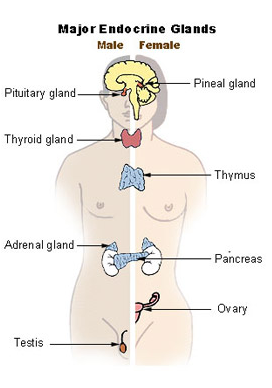Why in News?
Recent analysis at the Weizmann Institute in Rehovot, Israel shows the number of cells in an endocrine gland that secrete hormones.
Hormones are signaling molecules found in most multicellular organisms which facilitate communication between organs and tissues in body that are far apart. The signals regulate a wide range of physiological and behavioral processes, such as growth and maturation, sleep, digestive functions, and stress responses.
|
Endocrine Glands |
|||
|
|
Location |
Shape &/ Size |
Weight |
|
Pineal gland |
Midline of the brain |
A grain of rice |
50-150 mg |
|
Pituitary gland |
Hypothalamus of the brain |
A pea |
0.5–1 gram |
|
Thyroid gland |
Neck |
A butterfly in shape |
25 grams |
|
Parathyroid gland |
4 of which are in the neck |
Size of a lentil seed |
120 mg |
|
Thymus |
Between the lungs |
Pyramid-shaped lymphoid organ |
Average of 20 grams |
|
Adrenal glands |
Found atop each kidney |
Triangular-shaped glands |
5-10 grams in Adults |
|
Pancreas |
Behind the stomach |
Tadpole-shaped gland |
80-100 grams |
|
Ovaries |
On either side of uterus in female |
Oval-shaped glands |
|
|
Testis |
Underneath penis in male |
Round organs |
|

Thyroid hormones keep up metabolic balance throughout the body and Pancreas has a major role in secreting digestive enzymes.
References